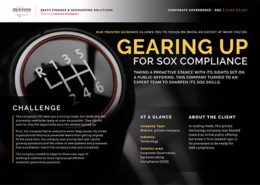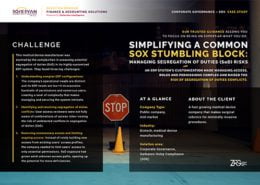Sarbanes-Oxley Compliance
You can finally design a SOX program that’s cost-effective and matches your company’s evolving risks and your auditors’ changing expectations.
Whether your company is headed toward an initial public offering or you will soon have to comply with SOX 404 as a public company, you have some work ahead of you. This work can also uncover great opportunities: A tailored Sarbanes-Oxley program, based on the way your company operates, can lead to greater efficiencies in your finance organization, ease the Sarbanes-Oxley audit process, and keep your company in compliance.
Read More / Less
The ultimate goal of a sound SOX compliance program: creating strong internal controls over financial reporting to prevent a material misstatement. Everything that goes into producing your financial statements – from the systems you use and the policies the finance team follows, to how you document decisions along the way – could use some refining to meet SOX reporting and Sarbanes-Oxley compliance requirements.
SOX experts will start with an assessment of the processes and documentation practices underlying your financial reporting. Are internal controls over financial reporting sound? Are they efficient? Or are there gaps that could lead to serious missteps or a heightened risk of fraud?
No one SOX program is the same. Every company has its own risks and its own ways of doing things. That’s why you want to work with SOX experts who will focus on designing, testing and monitoring controls based on your company’s size and growth stage, to create a workable, scalable SOX program that matches the needs of your company. And that minimizes the risk of deficiencies turning up in your internal control audits.
It’s rare that a company new to Sarbanes-Oxley compliance would have the level of in-house expertise necessary to take on an assessment and develop an effective SOX compliance program. RoseRyan SOX experts who have worked with hundreds of companies make the entire process easy on companies, by bringing a fresh perspective and practical ideas for streamlining SOX-related processes and procedures. They guide companies with a customized approach that works for the team. By getting to know the business, SOX experts can create a corporate governance solution that is easy for the company to maintain over time.
Read More / Less
RoseRyan has helped companies get through their inaugural SOX management assessments, readied companies for their first Sarbanes-Oxley audit, and fine-tuned existing SOX programs to make them much more efficient. They’ll eliminate redundancies and introduce efficiencies that can make your entire financial reporting infrastructure run more smoothly. Management will have assurance that nothing is missing.
Early on after SOX’s enactment, companies tried to conform to check-the-box approaches to SOX compliance, but that led to bloated controls and sky-high audit bills. Today, SOX programs can be built around each company and how it operates, not only for effectiveness but for cost efficiencies too. Your SOX program can be designed to be fully integrated with your company’s workflow. The focus is not about having every type of control possible but about having the right controls. RoseRyan can create a risk-based, cost-effective SOX compliance program that matches your company’s risks and meets auditor’s expectations.
What is SOX compliance?
The Sarbanes-Oxley Act was enacted in 2002 to protect investors from corporate fraud after a series of audit failures (Enron, WorldCom). Since then, public companies have affirmed the veracity of their financial reports with CEO and CFO certifications, management reports of internal controls over financial reporting, and auditor attestations of those reports. Being SOX compliant means your company has an internal control structure to support financial statements that can be trusted
What are SOX 404 controls?
Corporate finance organizations are usually referencing Section 404 (a.k.a. SOX 404) of the SOX Act when they talk about Sarbanes-Oxley compliance. Under 404(a), management assesses the effectiveness of the company’s internal controls over financial reporting and shares those findings annually. Then, for 404(b), an independent auditor weighs in on that assessment (not all public companies have to comply with the 404(b); the requirement depends on the company’s market capitalization and the timing of its IPO).
What are the 5 essential components?
When this question comes up, the answer can be found in the COSO internal control framework released in 2013. The Committee of Sponsoring Organizations of the Treadway Commission’s five components of its internal control framework are (1) control environment; (2) risk assessment; (3) control activities; (4) information and communication; and (5) monitoring activities.
How is a SOX audit done?
Just like an external auditor takes an objective, risk-based view of a company’s financial statements, an external auditor reviews what management reports about the company’s internal controls, and conducts internal control testing. You can expect questions to arise during the process. SOX experts who can anticipate auditors’ areas of focus can help you prepare for and respond to their queries.
What happens if you are not SOX compliant?
Companies that do not comply with SOX put the reliability of their financial reporting into serious doubt. Senior executives and the company can face fines and lawsuits from regulators and investors, and those who certified non-compliant financial reports could lose their livelihood and risk prison time if it turns out that fraud was involved.
Sarbanes-Oxley compliance is not a “set it and forget it” exercise. It requires regular revisiting, as the company, workforce, leadership, and risks change over time. Regulators and auditors’ top areas of focus change, too.
Read More / Less
Tone at the top, for instance, can take a dramatic shift when a new CEO takes the helm. A company that was previously exempt from the SOX requirement for external audit attestation on internal controls over financial reporting may find it’s now susceptible to SOX 404(b). Adoption of a new IT system could open up security risks. For example, SOC 1 reports, which companies review from their SaaS providers, can expose a new audit risk when service providers change auditors.
By asking you the right questions and paying attention to what other companies are doing, RoseRyan SOX experts are on top of the latest changes that matter to your SOX compliance program, to ensure that the company will continue to have solid internal controls. Ongoing testing and monitoring keeps internal controls up to date and prepares the company for the annual SOX audit. To keep your company in Sarbanes-Oxley compliance, they’ll make sure your internal controls address the latest risks.
When you align your company with RoseRyan’s experts who have steep SOX audit knowledge and SOX reporting know-how, tending to your SOX program will feel seamless. Your team can keep their focus on where it belongs – their day job – and management will have confidence in the company’s financial reporting and assurance when the time comes to sign off on internal controls.



Drop us a note in the form and one of our experts will set up a time to discuss the ways RoseRyan can help guide you to greatness.
tel: (510) 456-3056 x 400
[email protected]
"*" indicates required fields